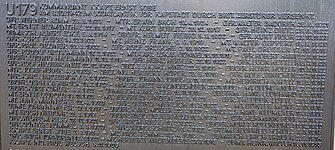German submarine U-179
| History | |
|---|---|
| Name | U-179 |
| Ordered | 28 May 1940 |
| Builder | |
| Yard number | 1019 |
| Laid down | 15 January 1941 |
| Launched | 18 November 1941 |
| Commissioned | 7 March 1942 |
| Fate | Sunk, 8 October 1942[1] |
| General characteristics | |
| Class and type | Type IXD2 submarine |
| Displacement | |
| Length |
|
| Beam |
|
| Height | 10.20 m (33 ft 6 in) |
| Draught | 5.35 m (17 ft 7 in) |
| Installed power |
|
| Propulsion |
|
| Speed |
|
| Range |
|
| Test depth | 230 m (750 ft) |
| Complement | 55 to 63 |
| Armament |
|
| Service record | |
| Part of: |
|
| Identification codes: | M 43 832 |
| Commanders: |
|
| Operations: |
|
| Victories: |
1 merchant ship sunk (6,558 GRT) |
German submarine U-179 was a
.Ordered on 28 May 1940, the
Design
The submarine had a maximum surface speed of 20.8 knots (38.5 km/h; 23.9 mph) and a maximum submerged speed of 6.9 knots (12.8 km/h; 7.9 mph).
First patrol and loss
U-179 sailed from Kiel on 8 September 1942 into the Atlantic, passing north of Scotland and then turned southwest through the gap between Iceland and the Faroe Islands. She headed south for the waters around Cape Town. She made her only kill on 8 October, sinking the unescorted SS City of Athens. All but one of the 99 crewmen survived. The survivors managed to recover a cat from the wreckage after the sinking.[4]
The boat was sunk by depth charges from the British destroyer HMS Active west southwest of Cape Town in South Africa on 8 October 1942. Sixty-one men died, there were no survivors.
Summary of raiding history
| Date | Name | Nationality | Tonnage (GRT) |
Fate[5] |
|---|---|---|---|---|
| 8 October 1942 | City of Athens | 6,558 | Sunk |
Gallery
-
U179 Memorial Plaque, Kiel
-
U179 Last position off Cape Town
-
U-Boat Memorial, Kiel
References
- ^ Kemp 1999, p. 91.
- ^ Helgason, Guðmundur. "The Type IXD2 boat U-179". German U-boats of WWII - uboat.net. Retrieved 22 July 2012.
- ^ a b c d Gröner 1991, pp. 74–75.
- ^ Helgason, Guðmundur. "City of Athens". German U-boats of WWII - uboat.net. Retrieved 8 October 2014.
- ^ Helgason, Guðmundur. "Ships hit by U-179". German U-boats of WWII - uboat.net. Retrieved 26 September 2014.
Bibliography
- Busch, Rainer; Röll, Hans-Joachim (1999). German U-boat commanders of World War II : a biographical dictionary. Translated by Brooks, Geoffrey. London, Annapolis, Md: Greenhill Books, Naval Institute Press. ISBN 1-55750-186-6.
- Busch, Rainer; Röll, Hans-Joachim (1999). Deutsche U-Boot-Verluste von September 1939 bis Mai 1945 [German U-boat losses from September 1939 to May 1945]. Der U-Boot-Krieg (in German). Vol. IV. Hamburg, Berlin, Bonn: Mittler. ISBN 3-8132-0514-2.
- Gröner, Erich; Jung, Dieter; Maass, Martin (1991). U-boats and Mine Warfare Vessels. German Warships 1815–1945. Vol. 2. Translated by Thomas, Keith; Magowan, Rachel. London: Conway Maritime Press. ISBN 0-85177-593-4.
- Kemp, Paul (1999). U-Boats Destroyed - German Submarine Losses in the World Wars. London: Arms & Armour. ISBN 1-85409-515-3.
External links
- Helgason, Guðmundur. "The Type IXD2 boat U-179". German U-boats of WWII - uboat.net. Retrieved 7 December 2014.
- Hofmann, Markus. "U 179". Deutsche U-Boote 1935-1945 - u-boot-archiv.de (in German). Retrieved 7 December 2014.



